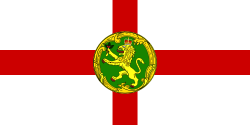Alderney
Assen
|
||||||
|---|---|---|---|---|---|---|
|
||||||
| Anthem: God Save the Queen (official) | ||||||
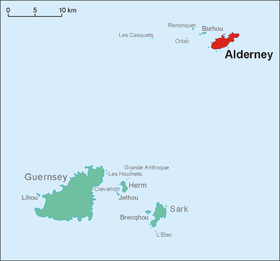 Location of Alderney (red) in relation to Guernsey.
|
||||||
| Capital | St. Anne | |||||
| Official languages | English | |||||
| Part of | Bailiwick of Guernsey | |||||
| Leaders | ||||||
| • | Duke | Queen Elizabeth II | ||||
| • | Head of Government | Stuart Trought | ||||
| Legislature | States of Alderney | |||||
| Establishment | ||||||
| • | Administrative separation from mainland Normandy | 1204 |
||||
| Population | ||||||
| • | estimate | 2,020[1] | ||||
| Currency | Pound sterlinga (GBP) | |||||
| Time zone | GMT | |||||
| • | Summer (DST) | (UTC+1) | ||||
| Calling code | +44 1481 | |||||
| Internet TLD | .gg (Guernsey) | |||||
| a. | Local coinage is issued, including the pound note (see Alderney pound). | |||||
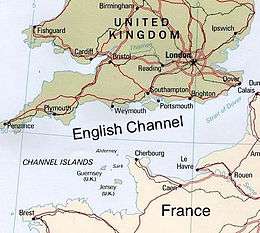

Alderney (/ˈɔːldərni/; French: Aurigny [oʁiɲi]; Auregnais: Aoeur'gny) is the most northerly of the inhabited Channel Islands. It is part of the Bailiwick of Guernsey, a British Crown dependency. It is 3 miles (5 km) long and 1 1⁄2 miles (2.4 km) wide. The area is 3 square miles (8 km2), making it the third-largest island of the Channel Islands, and the second largest in the Bailiwick. It is around 10 miles (15 km) from the west of La Hague on the Cotentin Peninsula, Normandy, in France, 20 miles (30 km) from the north-east of Guernsey and 60 miles (100 km) from the south coast of Great Britain. It is the closest of the Channel Islands to both France and the United Kingdom. It is separated from Cap de la Hague by the dangerous Alderney Race (French: Raz Blanchard).
As of April 2013, the island had a population of 1,903; natives are traditionally nicknamed vaques[2] after the cows, or else lapins[3] after the many rabbits seen in the island. Formally, they are known as Ridunians, from the Latin Riduna.
The only parish of Alderney is the parish of St Anne, which covers the whole island.
The main town, St Anne, historically known as "La Ville", (or "Town" in English), is often referred to as "St Anne's" by visitors and incomers, but rarely by locals (who, in normal conversation, still most frequently refer to the area centred on Victoria St simply as "Town"). The town's "High St", which formerly had a small handful of shops, is now almost entirely residential, crossing Victoria St at its highest point, forming a T-junction. The town area features an imposing church and an unevenly cobbled main street: Victoria Street (Rue Grosnez – the English name being adopted on the visit of Queen Victoria in 1854. There are a primary school, a secondary school, a post office, and hotels, as well as restaurants, banks and shops. Other settlements include Braye, Crabby, Longis, Mannez, La Banquage and Newtown.
History
Alderney shares its prehistory with the other islands in the Bailiwick of Guernsey, becoming an island in the Neolithic period as the waters of the Channel rose. Formerly rich in dolmens, like the other Channel Islands, Alderney with its heritage of megaliths has suffered through the large-scale military constructions of the 19th century and also by the Germans during the World War II occupation, who left the remains at Les Pourciaux unrecognisable as dolmens. A cist survives near Fort Tourgis, and Longis Common has remains of an Iron Age site. There are traces of Roman occupation[4] including a fort, built in the late 300s, at 49°43′09″N 2°10′36″W / 49.71917°N 2.17667°W above the island's only natural harbour.[5][6]
The etymology of the island's name is obscure. It is known in Latin as Riduna but as with the names of all the Channel Islands in the Roman period there is a degree of confusion. Riduna may be the original name of Tatihou, while Alderney is conjectured to be identified with Sarnia. Alderney/Aurigny is variously supposed to be a Germanic or Celtic name. It may be a corruption of Adreni or Alrene, which is probably derived from an Old Norse word meaning "island near the coast". Alternatively it may derive from three Norse elements: alda (swelling wave, roller), renna (strong current, race) and öy or -ey (island).[7] Alderney may be mentioned in Paul the Deacon's Historia Langobardorum (I.6) as 'Evodia' in which he discussed a certain dangerous whirlpool. The name 'Evodia' may in turn originate from the seven 'Haemodae' of uncertain identification in Pliny's Natural History (IV 16 (30) or Pomponius Mela's Chronographia (III 6,54).
Along with the other Channel Islands, Alderney was annexed by the Duchy of Normandy in 933. In 1042 William the Bastard, Duke of Normandy (later William the Conqueror, King of the English) granted Alderney to the Abbey of Mont Saint-Michel. In 1057 the bishop of Coutances took back control of the island.
After 1204, when mainland Normandy was incorporated into the kingdom of France, Alderney remained loyal to the English monarch in his dignity of Duke of Normandy.
Henry VIII of England undertook fortification works, but these ceased in 1554. Essex Castle perpetuates the name of the Earl of Essex, who purchased the governorship of Alderney in 1591. Prior to the Earl's execution for treason in 1601, he leased the island to William Chamberlain, and Alderney remained in the hands of the Chamberlain family until 1643. From 1612, a Judge was appointed to assist the Governor's administration of Alderney, along with the Jurats. The function of the Judge was similar to that of the Bailiffs of Guernsey and Jersey, and continued until 1949.
During the Wars of the Three Kingdoms, Alderney was held by a Parliamentary garrison under Nicholas Ling, Lieutenant-Governor. Ling built Government House (now the Island Hall). The de Carterets of Jersey acquired the governorship, later passing it to Sir Edmund Andros of Guernsey, from whom the Guernsey family of Le Mesurier inherited it, thus establishing a hereditary line of governors that lasted until 1825.
Henry Le Mesurier prospered through privateering, and moved the harbour from Longis to Braye, building a jetty there in 1736. Warehouses and dwellings were built at Braye, and the export of cattle generated wealth for the economy. The Court House was built in 1770 and a school in 1790. A Methodist chapel was constructed in 1790, following John Wesley's visit in 1787. A telegraph tower was constructed above La Foulère in 1811, enabling signals to be relayed visually to Le Mât in Sark and on to Guernsey – early warning of attack during the Napoleonic Wars was of strategic importance. With the end of those wars privateering was ended and smuggling suppressed, leading to economic difficulties.[4]
The last of the hereditary Governors, John Le Mesurier, resigned his patent to the Crown in 1825, and since then authority has been exercised by the States of Alderney, as amended by the constitutional settlement of 1948.
Victorian era
The British Government decided to undertake massive fortifications in the 19th century and to create a strategic harbour to deter attacks from France.[8] These fortifications were presciently described by William Ewart Gladstone as "a monument of human folly, useless to us ... but perhaps not absolutely useless to a possible enemy, with whom we may at some period have to deal and who may possibly be able to extract some profit in the way of shelter and accommodation from the ruins." An influx of English and Irish labourers, plus the sizeable British garrison stationed in the island, led to rapid Anglicisation. The harbour was never completed – the remaining breakwater (designed by James Walker) is one of the island's landmarks, and is longer than any breakwater in the UK.
Queen Victoria and Prince Albert visited Alderney on 9 August 1854.[9] The Albert Memorial and the renaming of Rue Grosnez to Victoria Street commemorate this visit.[4]
At the same time as the breakwater was being built in the 1850s, the island was fortified by a string of 13 forts, designed to protect the harbour of refuge. The accommodation quarters of several of the forts have been converted into apartments; two are now private homes; and one, Fort Clonque, at the end of a causeway that can be flooded at high tide, belongs to the Landmark Trust and can be rented for comfortable self-catering holidays for up to 13 people. Scenes from the film Seagulls Over Sorrento were shot at Fort Clonque in 1953.
Some of the forts are now in varying stages of dereliction, the most ruined being Les Hommeaux Florains, perched on outlying rocks, its access causeway and bridge having been swept away long ago. Houmet Herbé resembles a Crusader castle with its squat round towers. Like many of the forts, it included such apparently anachronistic features as a drawbridge and machicolation, which were still common in military architecture of the period.
Second World War
In June 1940 the entire population of Alderney, about 1,500 residents, were evacuated. Most went on the official evacuation boats sent from mainland Britain. Some, however, decided to make their own way, mostly via Guernsey, but due to the impending occupation many found themselves unable to leave and were forced to stay on Guernsey for the duration of the war. A few Alderney people elected not to leave Alderney with the general evacuation. However, boats from Guernsey came and collected them before the German Army arrived, on the basis that it was best for their personal safety. During the Second World War, the Channel Islands were the only part of the British Isles that was occupied by Germany, although other parts of the Empire were occupied by the Axis powers.
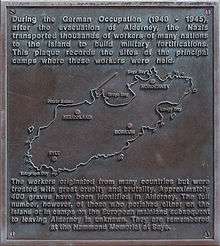
The Germans arrived to a deserted island, and began to follow their orders to fortify Alderney as part of Hitler's Atlantic Wall. In January 1942 they built four camps in Alderney: two work camps, Lager Helgoland and Lager Borkum, and two concentration camps, Lager Sylt and Lager Norderney. They were built by the Nazi Organisation Todt (OT) to house the labour used to build fortifications including bunkers, gun emplacements, tunnels, air-raid shelters and other concrete and field fortifications. Lager Norderney, containing Russian and Polish POWs, and the Lager Sylt camp holding Jewish slave labourers, were transferred to SS administration in March 1943 under the control of Hauptsturmführer Maximilian List. There are 397 graves in Alderney, which when added to the men who died in ships, takes the total to over 700 out of a total inmate population of 6,000 who lost their lives before the camps were closed and the remaining inmates transferred to France in 1944. On the return to their island, Alderney evacuees had little or no knowledge of the crimes committed on their island during the occupation, because by December 1945, the first date civilians could return home, all the slave labourers had been sent away and the majority of the German troops left behind were not senior staff. Evidence, however, was all over the island, with concrete fortifications and graveyards for the prisoners kept there during the occupation.
The Royal Navy blockaded the islands from time to time, particularly following the liberation of Normandy in 1944. Intense negotiations resulted in some Red Cross humanitarian aid, but there was considerable hunger and privation during the five years of German occupation, particularly in the final months when the Germans themselves were close to starvation. The Germans surrendered Alderney on 16 May 1945, eight days after the Allies formally accepted the unconditional surrender of the armed forces of Nazi Germany and the end of Adolf Hitler's Third Reich, and seven days after the liberation of Guernsey and Jersey. 2,332 German prisoners of war were removed from Alderney on 20 May 1945, leaving 500 Germans to undertake clearing up operations under British military supervision.[10] The people of Alderney could not start returning until December 1945 due to the huge cleanup operation needed simply to make the island safe for civilians. When the islanders returned home they were shocked to see the state of the island, with many houses completely derelict: the Germans had burned anything wooden, including front doors, for fuel. Archival and object evidence of the general evacuation in 1940 and the subsequent occupation of Alderney can be found in the Alderney Society Museum.
A series of tunnels also remain in place on Alderney, constructed by forced labour. These are in varying degrees of decay, being left open to the public and the elements.
Since 1945
For two years after the end of the war, Alderney was operated as a communal farm. Craftsmen were paid by their employers, whilst others were paid by the local government out of the profit from the sales of farm produce.[11] Remaining profits were put aside to repay the British Government for repairing and rebuilding the island. The local people resented being unable to control their own land; this led to the United Kingdom Home Office setting up an enquiry that led to the "Government of Alderney Law 1948", which came into force on 1 January 1949. The law organised the construction and election of the States of Alderney and the justice system; and, for the first time in Alderney, the imposition of taxes. The legislature and judiciary were separated. The position of Judge, who had headed the island's government since the resignation of the last Governor in 1825, was abolished, and the Jurats were removed from their legislative function.[4] Because of the island's small population, it was believed that the island could not be self-sufficient in running the airport and the harbour, or providing services that would match those of the UK. Taxes were therefore collected into the general Bailiwick of Guernsey revenue funds at the same rate as in Guernsey, and administered by the States of Guernsey. Guernsey became responsible for providing many government functions and services.
The 20th century saw much change in Alderney, from the building of the airport in the late 1930s to the death of the last speakers of the island's Auregnais language, a dialect of the Norman language. The economy has gone from depending largely on agriculture to earning money from the tourism and finance industries. E-commerce has become increasingly important, and the island hosts the domain name registry for both Bailiwicks and dozens of gambling website operators. Alderney has a full regulatory authority in operation.
As a result of these upheavals and of substantial immigration, the island has been more or less completely anglicised.
Politics
The States of Alderney (French: États d'Aurigny) is the legislature of the island; it sends two representatives to the States of Guernsey as well. The origin of the States is unknown, but it has operated from the Middle Ages.
The States of Alderney consists of the President, directly elected every four years, and ten States Members, half elected every two years for a four-year mandate. The President of the States of Alderney is Stuart Trought; in October 2012 he was re-elected for a further four-year period due to expire on 31 December 2016. The whole island is a single constituency.[12]
While Alderney enjoys full autonomy in law (except in matters of foreign affairs and defence, like the other Channel Islands and the Isle of Man), under the provisions of a formal agreement (known as "the 1948 Agreement") entered into between the Governments of Alderney and of Guernsey, certain matters have been delegated to Guernsey. These are known as 'the transferred services'.
Transferred services include policing, customs and excise, airport operations, health, education, social services, childcare and adoption. (The States of Alderney retains policy control of aviation to and from the island).
In return for providing the transferred services Guernsey levies various taxes and duties on Alderney. From 2016 Alderney will take back control of Tax on Real Property (TRP).
Immigration is the responsibility of the UK (UK law applies), with day-to-day operations carried out by the Guernsey Border Agency. In addition to the transferred services, both the UK and Guernsey may legislate on other matters with the consent of the States of Alderney.[13]
Law
Legal system
The Court of Alderney exercises unlimited original jurisdiction in civil matters and limited jurisdiction in criminal matters. The Court sits with a Chairman (the Judge of Alderney) and at least three of the six Jurats. Appeals are made to the Royal Court of Guernsey, which also exercises some original jurisdiction in criminal matters in Alderney, and thence to the Judicial Committee of the Privy Council.[14]
Taxation
For taxation purposes, Alderney is treated as if it were part of Guernsey.
Geography and natural history

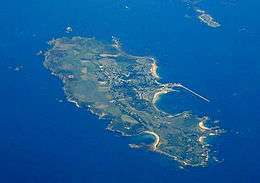
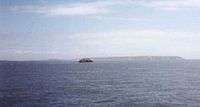
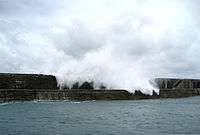
Alderney is similar to the other Channel Islands in having sheer cliffs broken by stretches of sandy beach and dunes. The highest point is on the central plateau of the island at 296 ft.[9]
Its climate is temperate, moderated by the sea, and summers are usually warmer than elsewhere in the British Isles.
Alderney and its surrounding islets support a rich flora and fauna. Trees are rather scarce, as many were cut down in the 17th century to fuel the lighthouses on Alderney and the Casquets. Those trees that remain include cabbage trees, due to the mild climate – often miscalled "palms" but of the lily family), and there are some small woods dotted about the island. Puffins on Burhou and gannets on Les Étacs (popularly called Gannet Rock) just off Alderney are a favourite of many visitors to the island.
About a quarter of Alderney hedgehogs are of the "white" or "blonde" variety, which does not carry fleas.[15] These are not albinos, but descent of rarely met blonde European hedgehogs, with a blonde pair released on the island in the 1960s.[16] The island had its own breed of cattle, called the Alderney. The pure breed became extinct in 1944, but hybrids remain elsewhere, though no longer on Alderney. In August 2005, the west coast of Alderney and associated islands, including Burhou and Ortac, were designated as Ramsar wetlands of international importance. The Alderney Wildlife Trust helps to manage the two nature reserves, at Longis and Vau du Saou.
The island is surrounded by rocks, which have caused hundreds of wrecks. There are treacherous tidal streams on either side of the island: the Swinge between Alderney and Burhou, just outside the harbour, and Le Raz between the island and the Normandy mainland. The Corbet Rock lies in the Swinge.
The geology of Alderney is mostly granites from the Precambrian period.
Culture
Language
The language of the island is now English with a few minor variants, constituting Channel Island English.
For centuries the island had its own dialect of the Norman language called Auregnais, now extinct. It was primarily a spoken language, with only a few known poems and written works using it.
French was once widely used on the island, and increasingly replaced Auregnais since the late 19th century, but ceased to be an official language there in 1966. French declined partly because of the many English and Irish workers in the island from 1850 onwards, building fortifications and providing the garrison soldiers; French fell out of use not only from neglect, especially in schools, but also because most of the population was evacuated in the Second World War.
However, there is a strong cultural legacy of both languages in the island: most of the local place-names are in French or Auregnais, as are many local surnames. The pronunciation of various local names is also dialectal, e.g. Dupont as "dip-oh" rather than in the traditional Parisian fashion, and Saye (the name of a beach on the island) as "soy". One or two French/Auregnais words are still in common use, e.g. vraic (seaweed fertiliser).
Sport
Golf, fishing and other water sports are popular, and there are many clubs and associations for sports and other leisure activities. Alderney competes in the biannual Island Games. Every September, the Alderney Air Races attract a number of aircraft to compete in the deciding and final round for the European Air Racing champtionship, organised by the Royal Aero Club. This involves high-speed circuits round the airfield, lighthouse, Casquets and then back around.
Pubs
Due in part to the tourist industry but mainly to the Ridunians' own drinking culture (there is a common expression elsewhere in the Channel Islands that Alderney is composed of 'two thousand alcoholics, clinging to a rock'[17]) there are many restaurants and public houses. There is a vibrant and lively nightlife which is enjoyed by many especially in the summer, and informal dance music events often take place in abandoned bunkers ('bunker parties') and more organised events in and around Alderney Week at the Corporation Quarry ('Quarry parties').
It was one of the last places in the British Isles to introduce a smoking ban in pubs, shops, restaurants and other indoor public places (Guernsey, Jersey, the UK, and the Isle of Man all having outlawed this already). The States of Alderney passed the anti-smoking legislation with the President's casting vote on 13 January 2010; the legislation came into force at 4am on 1 June 2010.[18]
The island has an ageing population and is popular with people wanting somewhere quiet to retire. Because it is quiet and secluded, Alderney has attracted some famous residents, including authors T. H. White (The Once and Future King) and Elisabeth Beresford (The Wombles), cricket commentator John Arlott, cricketer Sir Ian Botham, Beatles producer Sir George Martin, actress Dame Julie Andrews, and Olympic swimmer Duncan Goodhew.
Broadcasting
Alderney has its own radio station, QUAY-FM, which broadcasts on 107.1 and online. Initially it only operated at seasonal highpoints such as the summer Alderney Week festival, but from 2015 it has broadcast 24 hours a day. It features local news and interviews, music, news from Sky and overnight broadcasting from BBC World Service.
Alderney Week
Alderney Week is the island's annual summer festival, beginning the Saturday before the first Monday of August and lasting 8 days, it involves many of the islanders and attracts many visitors to the island.
Miss Alderney
Miss Alderney is chosen during the Easter Holiday weekend each year at a public event held at the Island Hall. Online application ensures complete anonymity until the winner is announced. Miss Alderney is chosen by a panel of judges made up by non-residents/holidaymakers.
Alderney Annual Motor Sprint and Hill Climb
- Every year in mid September Alderney hosts a motorsport weekend which is organized and run by the Guernsey Kart and Motor Club. The event has been running for over 20 years. This event proves very popular with mainly Guernsey drivers who come over to Alderney in their high powered cars, motorbikes, sidecars and karts. This event is not just open to Guernsey residents but anyone who has a racing licence etc. Details can be found on the .[19] Guernsey Kart and Motor Club website.
- Race vehicles are transported to Alderney on Alderney Shipping's Ship a couple of days before the events. On the Friday the Sprint is held at the normally public roads of Fort Corbelets in the east of the island. The road is closed for the day while the event is on and then re opened at night. The following day a Hill Climb is held at Fort Tourgis in the west of the island. This again is normally a public road which is again closed for the day. Both events are very fast and very competitive and much loved by the drivers. Many spectators travel from Guernsey to cheer on their friends and family. Many local Alderney people watch as the closed roads have vehicles racing at high speed where normally speed limits of 35 mph apply.
- Saturday evening, once the days racing has finished has an award ceremony where drivers are presented with trophies for their 2 days hard racing. This is also a good chance to relax and unwind.
Alderney Performing Arts Festival
This annual festival began in 2013, and features music, dance, theatre, etc.
Alderney Literary Festival
This festival began in March 2015, featuring talks and other events relating to historical fiction and non-fiction. It is organised by the Alderney Literary Trust.
Alderney Stones
In April 2011, sculptor Andy Goldsworthy completed a project called Alderney Stones, commenced in 2008, in which 11 large dried-earth spheres were placed at different sites on the island. The intention is that each stone will gradually erode, at different speeds depending on the location, and in some cases revealing objects buried inside.[20] Goldsworthy has stated that he selected Alderney as "It seems to have a strong sense of layered past and a wide variety of locations in a small area."[21]
Transport
Alderney is served by Alderney Airport. There are several flights each day from Southampton, Jersey (via Guernsey) and Guernsey, with links to many parts of the United Kingdom and Europe. Aurigny serves the island with Britten-Norman Trislanders and Dornier Do 228s.
Boats sail regularly between the island and France, and to the other Channel Islands. A high-speed passenger ferry is operated in summer by the French company Manche Iles Express to Diélette in the commune of Flamanville, Manche in France, and to St Peter Port, Guernsey. Weekly freight services, also carrying passengers, are operated by Alderney Shipping to Poole and St Peter Port. A 12-passenger boat, the Lady Maris II, operates regular services to Cherbourg, Sark and St Peter Port.[22] Alderney is 72.5 mi from St Malo and 70.3 mi from Poole.
There are also frequent boat trips available. Mainbrayce, a chandler's, provides water-taxi services and water and fuel to visiting yacht crews. This can get quite hectic during the peak months of June, July and August as nearly 30,000 yacht crew members visit this harbour every year.
Due to the island's size, vehicular transport is often unnecessary, although taxis, cars and bicycles are used. The Alderney Railway is the only remaining railway in the Channel Islands providing a timetabled public service, with scheduled trains to the lighthouse during the summer and special occasions such as Easter and Christmas. The railway brings a number of tourists to the island each year in the form of railway enthusiasts. During the summer season, there is an occasional bus service around the island.
Alderney allows people to ride motorbikes and mopeds without helmets and drive cars without seatbelts, but it is compulsory for under 18s to wear helmets. The international vehicle registration code is GBA.
Healthcare and emergency services
Ambulance
The St John Alderney Ambulance Service operates the ambulance service on the island, and is staffed by volunteers. It has served Alderney since 1952 and is registered as a private company.[23] Patients are transferred to the Mignot Memorial Hospital in St Anne, and any having major complications are then transferred to Guernsey or Southampton by the Aurigny on a 24-hour emergency basis. In the event of bad weather preventing an air evacuation the transfer is achieved with the aid of the RNLI lifeboat service. However, there is currently no paramedic service available on the island.
Fire Service
The Alderney Voluntary Fire Brigade has a crew of 10 volunteer firefighters, and a fleet of one water tender (with ladder), two further water carriers and also one Land Rover Defender. A new station was officially opened by Lt.-General Sir John Foley, the Lieutenant Governor of Guernsey, on 20 October 2004. Located near Braye Harbour, it gives an average response time of just 9 minutes and includes four appliance bays, a workshop, kit room, mess and a training room. The Alderney Airport Fire and Rescue Service is sometimes called to help with larger conflagrations.
Police
Because of Alderney's low crime rate,[24] day-to-day policing of Alderney is provided by a team of five locally based officers from the Guernsey Police, consisting of a sergeant in charge, two constables, and two special constables.[25] They are assisted by visiting constables from Guernsey on a regular basis. The police station is in QEII Street.
Lifeboats
The Alderney lifeboat station was established in 1869, closed in 1884 and re-established in 1985 by the RNLI, which serves Alderney with its all-weather Trent class lifeboat Roy Barker I.
Search and rescue
Search and rescue services are provided by Channel Islands Air Search, which uses a Britten-Norman Islander to search large areas of water using infrared cameras and a number of other technologies.[26] Formed in 1980, it is staffed entirely by volunteers and is based in Guernsey. When a major search is underway, the French coastguard and the Royal Navy are often also involved, co-ordinated by the Maritime Rescue Co-ordination Centre in Jobourg, France.
Numismatic history
- Alderney pound and coinage
- Postal orders of Alderney
In popular culture
- In the song "Alderney" on her 2013 album The Sea Cabinet, Gwyneth Herbert tells the story of the sudden evacuation of Alderney's inhabitants during the Second World War and the irrevocable changes introduced during the Nazi occupation of the island.[27][28]
Photos
Overlooking Braye Bay |
 Fort Clonque – Burhou in the background |
 The inner harbour, breakwater designed by James Walker in the background |
See also
- Fortifications of Alderney
- Alderney Steam Packet Company
- For further information on Nazi treatment of Jews and other people, see Holocaust
- Alderney camps
- The island is a key locale in the 1975 Jack Higgins novel The Eagle Has Landed
- Maritime history of the Channel Islands
- Archaeology of the Channel Islands
References
Inline
- ↑ "News report". BBC. 2016-04-08. Retrieved 2016-04-09.
- ↑ Dictionnaire Jersiais-Français, 1966; Customs, Ceremonies & Traditions of the Channel Islands, Lemprière, 1976, ISBN 0-7091-5842-4
- ↑ Dictionnaire Jersiais-Français, 1966
- 1 2 3 4 A Visitor's Guide to Guernsey, Alderney and Sark", Victor Coysh, 1983 ISBN 0-86190-084-7
- ↑ Alderney ruin found to be Roman fort 25 November 2011 http://www.bbc.co.uk/news/world-europe-guernsey-15888516 accessed 7 December 2011
- ↑ ALDERNEY’S ‘SHORE FORT’. Nicholas Hogben."My best guess is that the outer structure was constructed in the second half of the third century or later by the Roman navy around an existing combined harbour master's and revenue office, perhaps to protect it, and hence the island, from the ‘pirates’ that Carausius hunted." THE ASSOCIATION FOR ROMAN ARCHAEOLOGY Newsletter no. 23, not dated. http://www.associationromanarchaeology.org/ARA%20Newsletter23.part2.pdf
- ↑ "Old Norse Words in the Norman Dialect". Viking Network.
- ↑ Davenport, T.G., Partridge CW, "The Victorian Fortification of Alderney", Fort (Fortress Study Group), 1980, (8), pp21-47
- 1 2 Portrait of the Channel Islands, Lemprière, London 1970
- ↑ The German Occupation of the Channel Islands, Charles G. Cruickshank, The Guernsey Press, (1975) ISBN 0-902550-02-0
- ↑ Bonnard, Brian. Alderney From Old Photographs. Amberley Publishing Limited, 2013. ISBN 9781445626475.
- ↑ "States Members". States of Alderney.
- ↑ Archived January 17, 2012, at the Wayback Machine.
- ↑ Court Of Alderney
- ↑ The blonde hedgehogs of Alderney. http://www.wildlifeextra.com/go/uk/blonde-hedgehogs.html#cr accessed 7 December 2011
- ↑ "Pictured: The rare baby hedgehog who has blonde prickles | Mail Online". Dailymail.co.uk. 2008-09-10. Retrieved 2013-04-01.
- ↑ "Channel hopping: also "On Sark, they mainly gossip, play bridge and drink – on Alderney they just drink" (personal recollection)Lucy Golding finds Alderney is a world away from commercial-centric holidays". Oxford Mail.
- ↑ "Alderney Journal". Alderney Journal. 2010-01-14. Retrieved 2013-04-01.
- ↑ "Guernsey Kart and Motor Club".
- ↑ "Alderney Stones". Alderney Stones. Retrieved 2013-04-01.
- ↑ "Andy Goldsworthy « Arts & Islands". Artandislands.com. Retrieved 2013-04-01.
- ↑ "Visit Alderney: How to Travel to Alderney by Air or Sea". Alderney – The Channel Island.
- ↑ "States of Alderney Emergency Services". States of Alderney. Retrieved 3 December 2011.
- ↑ "Moving to the tax haven of Alderney, Channel Islands". This is Money. Retrieved 3 December 2011.
- ↑ The establishment is listed here by name and rank.
- ↑ "Channel Islands Air Search". Channel Islands Air Search. Retrieved 3 December 2011.
- ↑ Sebastian Scotney (15 May 2013). "Podcast: A Few Minutes with... Gwyneth Herbert". London Jazz News. London Jazz. Retrieved 6 October 2013.
- ↑ Gwyneth Herbert (2013). "Alderney Original Demo". SoundCloud. Retrieved 6 October 2013.
General
- The Alderney Story: 1939–1949, Michael St John Packe and Maurice Dreyfus (1966?) "The Alderney Society and Museum decided shortly after its inception in 1966 to collect all reliable reminiscences whether written or verbal lest with the passage of time they would be lost."
- Alderney Place Names, Royston Raymond, 1999 Alderney ISBN 0-9537127-0-2
- Noms de lieux de Normandie, René Lepelley, 1999 Paris ISBN 2-86253-247-9
External links
- Alderney official site
- Visitor information
- Alderney language
- Alderney Gambling Control Commission
- For further information on Alderney camps, see
- Christine O'Keefe, Appendix F: Concentration Camps: Endlösung – The Final Solution, retrieved 2009-06-06
- Matisson Consultants, Aurigny ; un camp de concentration nazi sur une île anglo-normande (English: Alderney, a Nazi concentration camp on an island Anglo-Norman) (in French), retrieved 2009-06-06
Coordinates: 49°42′52″N 2°12′19″W / 49.71444°N 2.20528°W
